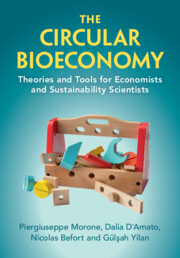Book contents
- The Circular Bioeconomy
- The Circular Bioeconomy
- Copyright page
- Contents
- Figures
- Tables
- Preface
- Acknowledgements
- Note on the Text
- Abbreviations and Notations
- Part I
- Part II
- 4 Environmental Economics and the Bioeconomy
- 5 Sustainability Transition and the Bioeconomy
- 6 The Role of Bioeconomy towards Safe and Just Sustainability Transformations
- Part III
- Index
- References
4 - Environmental Economics and the Bioeconomy
from Part II
Published online by Cambridge University Press: 26 October 2023
- The Circular Bioeconomy
- The Circular Bioeconomy
- Copyright page
- Contents
- Figures
- Tables
- Preface
- Acknowledgements
- Note on the Text
- Abbreviations and Notations
- Part I
- Part II
- 4 Environmental Economics and the Bioeconomy
- 5 Sustainability Transition and the Bioeconomy
- 6 The Role of Bioeconomy towards Safe and Just Sustainability Transformations
- Part III
- Index
- References
Summary
Our objective in this chapter is to provide an overview of resource and environmental economics by putting environmental economic theories in the context of bioeconomy, and by outlining the fundamental characteristics of an economics approach to environmental analysis. The analysis develops along three lines: (1) market failures and the environment,; (2) sustainability and intergenerational equity,; (3) optimal management of resources. To this end, the chapter provides a discussion on the economy– environment interdependence, how this concept develops in the context of bioeconomy (including a discussion on the circular use of resources), and which tools can be used to model it.
- Type
- Chapter
- Information
- The Circular BioeconomyTheories and Tools for Economists and Sustainability Scientists, pp. 59 - 85Publisher: Cambridge University PressPrint publication year: 2023



